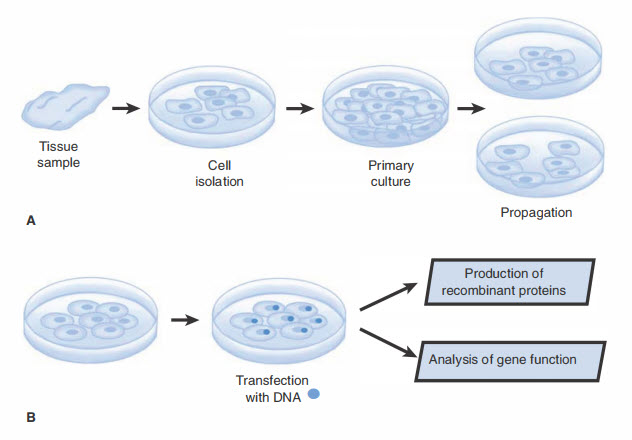Question 12#
When performing cell culture, cells should be:
A. Maintained in culture indefinitelyB. Fed with fresh medium every 2 to 3 days and split when they reach confluency
C. Prepared on surfaces wiped with a 50% ethyl alcohol solution
D. Maintained in a dehumidified carbon dioxide incubator at 37°F
Correct Answer is B
Comment:
Cell culture has become one of the most powerful tools in biomedical laboratories, as cultured cells are being used in a diversity of biologic fields ranging from biochemistry to molecular and cellular biology. Through their ability to be maintained in vitro, cells can be manipulated by the introduction of genes of interest (cell transfection) and be transferred into in vivo biologic receivers (cell transplantation) to study the biologic effect of the interested genes (Fig. below). In the common laboratory settings, cells are cultured either as a monolayer (in which cells grow as one layer on culture dishes) or in suspension. It is important to know the wealth of information concerning cell culturing before attempting the procedure. For example, conditions of culture will depend on the cell types to be cultured ( eg, origins of the cells such as epithelial or fibroblasts, or primary versus immortalized/transformed cells). It is also necessary to use cell type-specific culture medium that varies in combination of growth factors and serum concentrations. If primary cells are derived from human patients or animals, some commercial resources have a variety of culture media available for testing. Generally, cells are manipulated in a sterile hood, and the working surfaces are wiped with 70 to 80% ethyl alcohol solution. Cultured cells are usually maintained in a humidified carbon dioxide incubator at 37°C (98.6°F) and need to be examined daily under an inverted microscope to check for possible contamination and confluency (the area cells occupy on the dish). As a general rule, cells should be fed with fresh medium every 2 to 3 days and split when they reach confluency. Depending on the growth rate of cells, the actual time and number of plates required to split cells in two varies from cell line to cell line. Splitting a monolayer requires the detachment of cells from plates by using a trypsin or collagenase treatment, of which concentration and time period vary depending on cell lines. If cultured cells grow continuously in suspension, they are split or subcultured by dilution. Because cell lines may change their properties when cultured, it is not possible to maintain cell lines in culture indefinitely.

Cell culture and tra nsfection. A. Primary cells can be isolated from tissues and cultured in medium for a limited period of time. After genetic manipulations to overcome the cell aging process, primary cells can be immortalized into cell lines for long-term culture. B. DNA can be introduced into cells to produce recombinant gene products or to analyze the biologic functions of the gene.